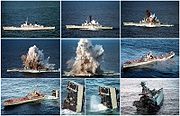.gif)
HMAS Farncomb (SSG 74)
Encyclopedia
HMAS Farncomb (SSG 74) is the second of six Collins class
Collins class submarine
The Collins class is a class of six Australian-built diesel-electric submarines operated by the Royal Australian Navy . The Collins class takes its name from Australian Vice Admiral John Augustine Collins; all six submarines are named after significant RAN personnel who distinguished themselves in...
submarines operated by the Royal Australian Navy
Royal Australian Navy
The Royal Australian Navy is the naval branch of the Australian Defence Force. Following the Federation of Australia in 1901, the ships and resources of the separate colonial navies were integrated into a national force: the Commonwealth Naval Forces...
(RAN).
Named for Rear Admiral Harold Farncomb
Harold Farncomb
Rear Admiral Harold Bruce Farncomb, CB, DSO, MVO was a lawyer and Australian Rear Admiral who served in both World War I and World War II. He was the first Australian-born RAN officer to reach a flag rank in the RAN...
, the submarine was laid down in 1993 and launched in December 1995—the first submarine to be completely constructed in Australia.
A combination of factors led to Farncomb being the only vessel of her class in operational condition in mid-2009.
Construction
Farncomb was laid down by Australian Submarine CorporationAustralian Submarine Corporation
The ASC, formerly Australian Submarine Corporation, is a wholly government-owned Australian naval defence company headquartered at Osborne in Adelaide, South Australia.-History:...
(ASC) on 3 March 1991. She was named for Rear Admiral Harold Farncomb
Harold Farncomb
Rear Admiral Harold Bruce Farncomb, CB, DSO, MVO was a lawyer and Australian Rear Admiral who served in both World War I and World War II. He was the first Australian-born RAN officer to reach a flag rank in the RAN...
; the first Australian-trained officer promoted to Captain
Captain (naval)
Captain is the name most often given in English-speaking navies to the rank corresponding to command of the largest ships. The NATO rank code is OF-5, equivalent to an army full colonel....
, and commanding officer of the flagship from 1941 to 1944. Work on the boat was delayed by the need to complete sister boat and class lead to a launchable condition by her set launch date of 28 August 1993. To free up resources at ASC for Collins, Farncombs bow section was sent to Newcastle for completion.
Farncomb was launched on 15 December 1995: as she was the first submarine to be completely constructed in Australia (two sections of Collins had been assembled in Sweden), the submarine wore a large Made In Australia logo on the fin.
Trials
Farncomb commenced sea trials in September 1996. Lessons learned from the trials of lead boat Collins benefitted Farncomb, with training materials improved and the trials crew instructed to familiarise themselves with the submarine while she was being completed (the crew of Collins had the option to, but most personnel did not). The trial program was impacted on by problems with Collins.Farncomb was provisionally accepted into service by the RAN at the end of 1997. She was formally commissioned into the RAN on 31 January 1998.
Operational history
In May 1997, two groups of six female sailors were posted to Collins and Farncomb as a test on the feasibility of mixed-sex crews aboard submarines. Following the trial's success, eleven female sailors and one female officer commenced training for the submarine service in 1998, making Australia the second nation in the world (following Norway in 1995) to allow women to serve on submarines.In 1998, while returning from Timor, all three of Farncomb’s diesel generators broke down. The submarine limped to Darwin, where she waited several weeks for replacement parts to be organised and transported.

On 19 March 2007, during a five-month intelligence-gathering mission in Asian waters, fishing lines became entangled in Fancomb’s propellor. The submarine surfaced in international waters during the calm night, and five sailors were out on the casing attempting to free the propellor when the weather suddenly worsened and the sailors were washed overboard. A rescue party, involving three volunteer swimmers was successful in retrieving the five sailors during a ninety-minute effort, and the submarine continued on without detection. The incident remained classified until August 2009, when the RAN nominated the three rescue swimmers for bravery decorations, the first submariners to be nominated since a 1981 incident aboard .
In 2008 and 2009, personnel shortages reduced the number of submarines able to be deployed to three, with the maintenance schedule and battery malfunctions on several boats combining to reduce this to one, Farncomb in mid-2009.
On the morning of 13 March 2009, Farncomb was one of seventeen warships involved in a ceremonial fleet entry and fleet review in Sydney Harbour, the largest collection of RAN ships since the Australian Bicentenary
Australian Bicentenary
The bicentenary of Australia was celebrated in 1970 on the 200th anniversary of Captain James Cook landing and claiming the land, and again in 1988 to celebrate 200 years of permanent European settlement.-1970:...
in 1988. The submarine did not participate in the fleet entry, but was anchored in the harbour for the review.
In January 2010, Farncomb was forced to return to port for urgent repairs after a generator failure. This left sister boat as the only fully operational submarine, with on restricted duties, and the other four submarines undergoing repairs or maintenance.

